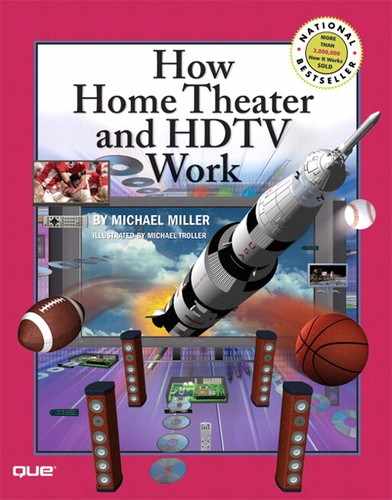
Surround sound for home video has been around in one form or another for more than 20 years. Today’s most popular surround format is Dolby Digital, which can reproduce up to 5.1 channels of audio. The five primary channels are front left, front center (typically located just above or below the television screen), front right, left surround, and right surround. While many listeners mistakenly place their surround speakers at the rear of the room, these speakers are designed to literally surround the listener by being placed to the sides of the primary listening location, level with or just slightly behind your ears.
The “.1” part of the equation is a separate low frequency effects (LFE) channel that reproduces the very lowest bass information. This channel is fed to a powered subwoofer, which can be located anywhere within your listening space.
Some new systems include 6.1– or 7.1–channel surround technology. The sixth and seventh channels are true rear channels; these speakers should be located directly behind the listener. In a 6.1/7.1–channel system, you end up with speakers in front of you (left, center, and right front), speakers beside you (left and right surround), and speakers behind you (left and right rear). With this setup, you’re literally surrounded by sound; you’re put in the middle of a movie soundtrack, with gunshots, explosions, and other special effects whizzing past your head, all around the room.
All surround–sound technologies encode the audio information on the movie’s normal soundtrack. Older technologies (such as Dolby Pro Logic) “hid” the rear–channel information within the front–channel information, using matrixing algorithms to mix the different channels together for storage or transmission and then separating the information on playback. Newer technologies (such as Dolby Digital and DTS) dedicate discrete data tracks for each channel of information, thus providing more precise positioning and eliminating channel leakage. (Although, just to be confusing, one of the newest formats—Dolby Digital EX —adds rear channels that are matrixed within the discrete left and right surround channel information.)
Two companies compete in the home surround sound market. The market leader is Dolby Laboratories, with its popular Dolby Digital, Dolby Digital EX, Dolby Pro Logic, and Dolby Pro Logic IIx formats. Dolby competes with Digital Theater Systems, with its similar DTS, DTS ES, and DTS Neo:6 formats. Most DVDs come encoded with Dolby Digital soundtracks, although some support DTS; the new HDTV broadcast standard mandates Dolby Digital soundtracks.
Two surround sound formats, Dolby Pro Logic IIx and DTS Neo:6, are specially designed to simulate surround sound from standard two–channel programming, such as music CDs and video games. Computer technology is used to analyze the original audio and create pseudo–surround effects; the results are variable, as you might expect, but often surprisingly realistic!
Technology marches on, of course, and Dolby Laboratories and Digital Theater Systems have introduced even newer formats to take advantage of the increased bandwidth promised by the upcoming generation of high–definition DVDs. Dolby Digital Plus offers 7.1 discrete channels at a higher bit rate than normal Dolby Digital; Dolby TrueHD offers lossless encoding for even better fidelity; and DTS HD offers both lossless encoding and an unlimited number of surround channels. The best is yet to come!





